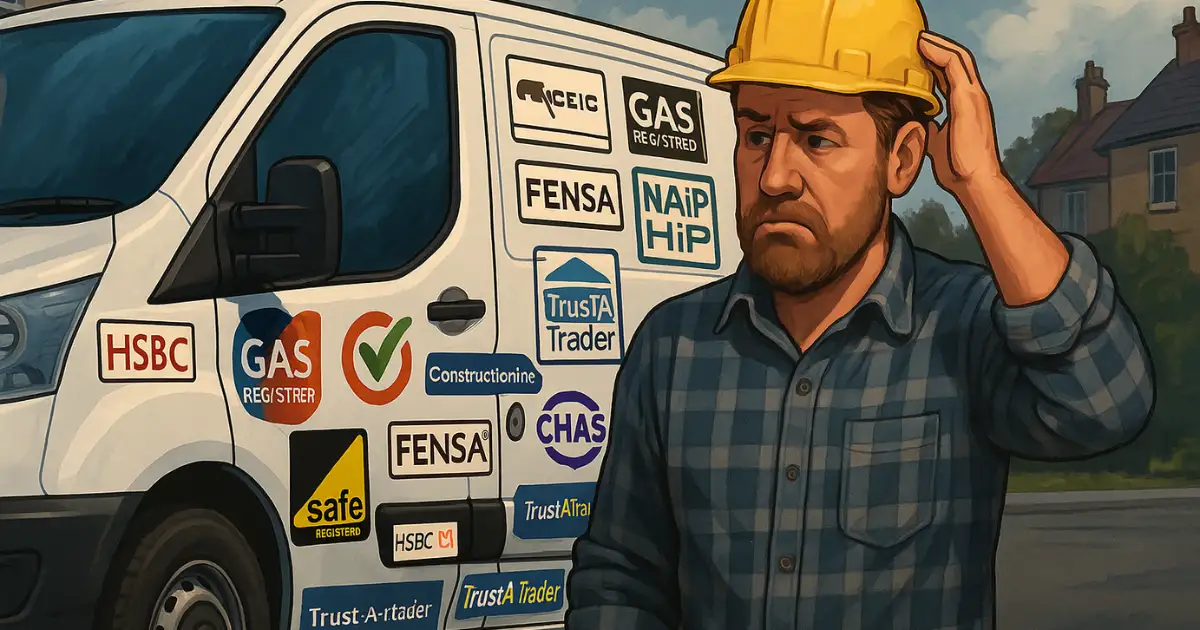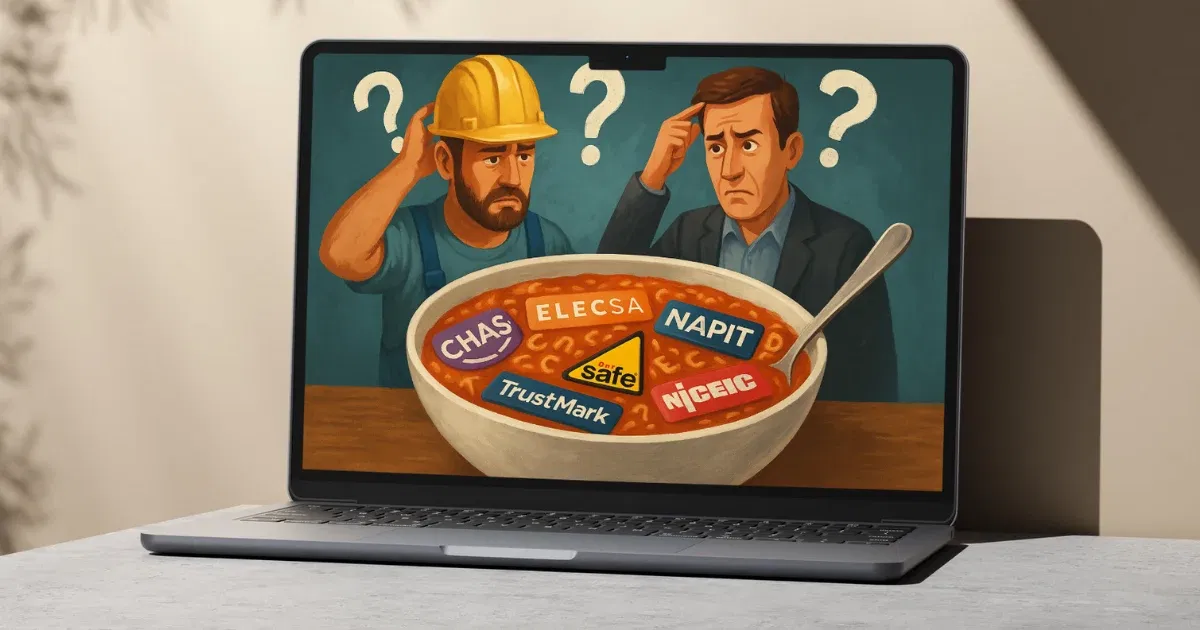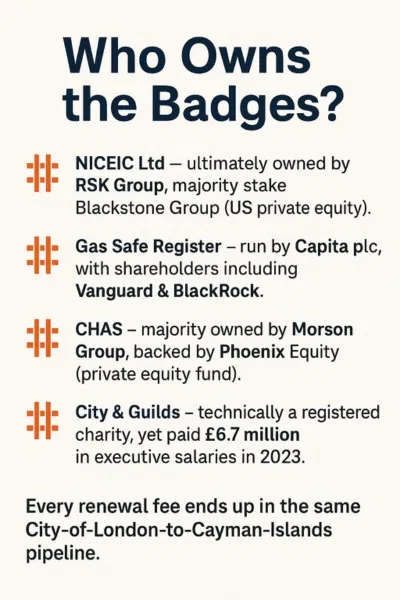
1. The £800-a-Year “You’re Good Enough” Sticker
What’s the real cost of being “trustworthy” in UK construction? It’s not just sweat on-site, it’s sticker fees off-site. A system built around badges, renewals, and audits is quietly draining SME builders dry.
Ask any sparks how much it costs to keep a NICEIC Approved Contractor badge on the van, and the answer is quick-fire:
- £395–£1,195 to join
- £245–£695 every year after
- £150–£300 per extra half-day inspection if the inspector fancies another look (NICEIC tariff 2024)
Multiply that by NAPIT, ELECSA, FENSA, Gas Safe, CSCS NVQ cards, CHAS, Constructionline, TrustMark, PAS 2030, CITB levy… and a typical SME builder is coughing up £800–£1,600 a year before they’ve even picked up a hammer.
2. The Grand Illusion – Safety vs. Revenue
Most certification bodies frame their badges as safeguards for the public. In truth, many are simply revenue machines with little real scrutiny behind them. It’s not safety driving these stickers, it’s profit.
| Sticker claims | What it actually proves | Who pockets the money |
|---|---|---|
| “Gas Safe registered” | Sat a 45-minute multiple-choice test once | Capita (£199–£399 per engineer, £149 renewal) |
| “NICEIC Approved” | Passed a half-day office audit | NICEIC Ltd (£1 m+ profit, £1.1 m director pay) |
| “FENSA certificate” | Window fitter paid £139 for a tick-box form | Fensa Ltd (£9.8 m turnover, £2.7 m dividends) |
| “NVQ Level 2” | Paid £1,200 to a training mill to watch videos | Private colleges linked to Pearson & City & Guilds |
| “CHAS accredited” | Uploaded insurance PDF online | CHAS Ltd (£15 m turnover, 28% margin) |
These aren’t safety measures, they’re branded subscriptions, sold as protection while funnelling millions to private bodies and investors.
Data drawn from: Companies House filings 2024

3. The Fake Safety Numbers
When people see stickers like Gas Safe, NICEIC, or FENSA, they assume someone’s checked the work, double-checked the qualifications, and stepped foot on site. That’s the story we’re sold. But the data tells a different one.
Gas Safe – Register Investigation (Daily Mail, 2023)
1 in 10 engineers on the register were found working illegally. There was also a 23% rise in gas-related incidents despite mandatory certification and safety badges.
NICEIC – Parliamentary Evidence (2022)
MPs were told that NICEIC had no effective enforcement. In fact, 15% of all electrical fires involved NICEIC-registered contractors, the very people meant to reduce the risk.
FENSA – Audit Sample (Trading Standards, 2023)
Nearly 1 in 3 installations certified under FENSA failed Building Regs, with missing safety glass, poor ventilation, and zero rectification by the scheme.
Translation: the sticker does not make you safer – it just makes you poorer.
4. The Paper Mill – How NVQs Became Big Business
The CITB Skills Levy (£120–£600 per worker) funnels cash into City & Guilds, EAL and a burgeoning industry of “assessment centres” that charge £1,200–£2,000 for a Level 2 NVQ – a qualification that can be sat in a Portakabin with a tick-sheet.
- ✔ CSCS card fee: £36 to CITB
- ✔ Mandatory HS&E test: £21 to CITB
- ✔ NVQ “evidence portfolio”: £1,200 to a private centre
- ✔ Annual renewal: £36 again
A bricklayer with 25 years on the hod is told he needs a Level 2 NVQ in Bricklaying to keep his CSCS labourer card – and the training video is filmed by a 19-year-old who’s never laid a block.
Data drawn from: CITB Levy and Grants Information
5. PAS 2030 & TrustMark – The Retrofit Racket
To access £5 billion in government insulation grants, installers are forced to become PAS 2030:2019 certified and TrustMark registered. Sounds like a boost for green retrofits, until you check the price tag.
- ✔ Setup costs: £2,500–£4,000 for certification
- ✔ Annual surveillance audit: £800
- ✔ Per-measure assessment: £300 each
The result? 40% of small firms walked away from the Green Homes Grant because the paperwork cost more than the job profit.
Data drawn from: BEIS Impact Survey 2022/em>
6. Case Studies – Real Builders, Real Costs
These aren't hypotheticals or edge cases. They're real builders from across the UK who shared their annual certification costs and the jobs lost due to red tape. None of them are cutting corners, just trying to stay in business while drowning in forms and fees.
| Trade | Years Experience | Annual Cert Bill | Jobs Lost to Paperwork | Quote |
|---|---|---|---|---|
| Spark (Sole trader) | 32 | £1,340 | 6 small rewires | “I spend more time uploading certs than pulling cable.” |
| Bricklayer | 28 | £890 | 3 garden walls | “Apprentice’s NVQ cost more than his first-year wages.” |
| Window Fitter | 19 | £1,050 | 2 conservatories | “FENSA man spent 20 minutes in the van, charged £139.” |
| Plumber | 25 | £1,100 | 4 bathroom suites | “Gas Safe renewal email came the day after my van broke – priorities, eh?” |
These aren’t the builders taking shortcuts. They’re the ones who show up, do it right, and still get squeezed by a system designed to profit off “compliance” at every turn.
The Tipping Point – Real Builder, Real Burnout
Mick had been on the tools 32 years. He wasn’t new, he wasn’t green, and he wasn’t cutting corners. But by 2022, the paperwork mountain finally got the better of him.
He paid over £1,400 in badge renewals, got rejected from a local retrofit scheme for missing one accreditation, and missed his daughter’s school play while filling in compliance forms, for a job that never materialised.
“I don’t mind grafting. I do mind paying £200 to prove I’m not a cowboy when I’ve never had a callback in three decades.”
In the end, he walked. Left TrustMark. Cancelled NICEIC. Now works off referrals and a WhatsApp group.
“Best decision I’ve made.”
7. Who Owns the Badges?
You pay hundreds, sometimes thousands, each year to keep your certifications active. But where does that money actually go? Not into site inspections or safer homes. It vanishes into a web of holding companies, investment funds, and international shareholders.
- NICEIC Ltd – ultimately owned by RSK Group, with majority control held by Blackstone Group (US private equity).
- Gas Safe Register – operated by Capita plc, whose shareholders include Vanguard and BlackRock.
- CHAS – majority-owned by Morson Group, backed by Phoenix Equity (private equity fund).
- City & Guilds – technically a charity, yet paid £6.7 million in executive salaries in 2023.
These are the people profiting from your badges. Not the scheme runners, not regulators, not even reinvestment into the trades. Just more revenue for shareholders, investor dividends, and multi-million-pound salary boards.
Every annual fee, every renewal, every compliance add-on flows up into the same financial pipeline, from your job sheet in Kent to a fund manager’s portfolio in New York. It’s regulation, repackaged as revenue.
Data drawn from: Companies House filings, Capita/HSE contracts, Onex-Morson investment announcements, and City & Guilds annual reports.

8. The Safety Stats They Don’t Print
Short answer: No – the badges haven’t moved the needle on safety or cock-ups one inch. The numbers are in, and the sticker brigade has made one thing safer: director bonuses.
Electrical Fires & Gas Explosions – Same Cowboys, Shinier Lanyards
| Metric | Pre-badge era (2000–2008) | Post-badge era (2016–2023) | Change |
|---|---|---|---|
| Electrical Fires (UK) | ~4,300 / yr | ~4,100 / yr | ↓ 5% – within statistical noise |
| Gas Explosions | 31 major incidents | 34 major incidents | ↑ 10% |
| Rogue-trader Complaints | 52,000 / yr | 48,000 / yr | ↓ 8% – but complaints now hidden by platforms |
Conclusion: Same headcount of cowboys. Just newer lanyards and more expensive badges.
Bottom Line – What the Numbers Shout
- Accidents, fires, explosions, complaints have bounced around the same range for two decades.
- Certification increases paperwork, admin jobs and director bonuses, not safety.
- Bad trades still exist because bad enforcement still exists… the badge just shifts the blame onto the next bit of plastic.
If the stickers worked, the graph would slope down. It doesn’t.
9. How the Scam Grows – The Feedback Loop
Once the “cowboy” narrative takes hold, the cycle kicks in. And like all good rackets, it feeds itself:
- 🔁 Accident happens → media screams “cowboys”
- 🔁 Government announces new scheme → more badges to buy
- 🔁 Training mills & badge sellers lobby hard → fees rise again
- 🔁 Good trades priced out → market shrinks
- 🔁 Prices rise, quality falls → repeat step 1
It’s a loop that protects the profiteers, not the public.
10. Why Big Firms Love the Badge System (and Never Struggle With It)
The sticker circus looks very different when you’ve got lawyers on payroll and taxpayers footing the bill. Here’s how the big firms game the system, while the small firms pick up the tab:
1. Bulk-Buy Badges, Wholesale Price
• Barratt, Persimmon, Taylor Wimpey sign umbrella deals that cover every trade across every site.
• Cost per head? £60–£80 vs the £200–£400 a sole trader pays.
• They lock in multi-year rates and avoid the annual hike altogether.
2. In-House Compliance Squads = Zero Paperwork for the Lads on Site
• SME builders chase inspectors on cracked phones.
• Kier’s compliance team sits in an office pushing renewals, funded via project overheads billed to you, the taxpayer.
3. Audit Exemptions Written Into the Rules
• NHBC giants get a Part P waiver, smaller firms don’t.
• Large gas contractors test in-house. Sole traders sit external tests under stricter scrutiny.
4. Grants & Tax Breaks for “Being Green”
• Barratt claims £2k–£5k per plot under the Home Building Fund.
• Morgan Sindall banked £4.7m in R&D tax credits for speeding up compliance, not innovation.
5. Seats on the Boards – Writing the Rules They Cash In On
• A Persimmon director helps set FENSA standards.
• Balfour Beatty influences Constructionline fees, low for them, rising for the rest.
• Serco runs backend systems for Gas Safe, CHAS and Constructionline. That’s like the casino owning the shuffling machine.
6. PR Gold Stars on the Cheap
• “Carbon Trust Certified” wins ESG points that lower their interest rates.
• The brickie? He’s told to cough up another £200 for a CSCS card to enter the same site.
Bottom line: The badge system isn’t a safety net, it’s a barbed-wire fence that keeps the little guys out while multinationals stroll through the gate they helped build.
11. The Bottom Line – Who Does the Badge Really Serve?
Let’s not sugar-coat it. The badge game was never built for small firms. It was designed to look like safety – but act like a toll booth.
Local builders are paying thousands a year in fees, red tape, and “compliance” costs that do nothing to improve quality, safety or trust. Meanwhile, the same badges give big firms a discount, a shortcut, and a PR boost, all while they cash public grants and steer the rules from boardroom seats.
Enough’s enough.
If you're a homeowner, use local builders, not logos. Ask questions. Visit jobs. Check reviews that aren’t behind a paywall.
If you're a builder, speak up. Tell your story, on your social media or in the local FB Group. Join others pushing back against the scam.
If you're a local official, stop handing multimillion-pound contracts to national chains hiding behind shiny stickers. Back local trades who live and work in the community.
And as for sharing this with your MP? You could. But chances are, he’s already a shareholder.
Share this exposé. With your mates. With your family. With every builder and homeowner who’s sick of paying for plastic. Because if we all stop playing the badge game, it loses its power.
All source documents referenced in this blog are maintained on our Verified Sources Page.
